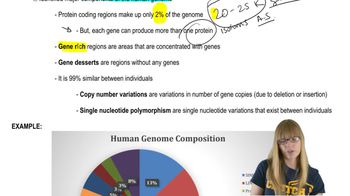Describe the human genome in terms of genome size, the percentage of the genome that codes for proteins, how much is composed of repetitive sequences, and how many genes it contains. Describe two other features of the human genome.
Table of contents
- 1. Introduction to Genetics51m
- 2. Mendel's Laws of Inheritance3h 37m
- 3. Extensions to Mendelian Inheritance2h 41m
- 4. Genetic Mapping and Linkage2h 28m
- 5. Genetics of Bacteria and Viruses1h 21m
- 6. Chromosomal Variation1h 48m
- 7. DNA and Chromosome Structure56m
- 8. DNA Replication1h 10m
- 9. Mitosis and Meiosis1h 34m
- 10. Transcription1h 0m
- 11. Translation58m
- 12. Gene Regulation in Prokaryotes1h 19m
- 13. Gene Regulation in Eukaryotes44m
- 14. Genetic Control of Development44m
- 15. Genomes and Genomics1h 50m
- 16. Transposable Elements47m
- 17. Mutation, Repair, and Recombination1h 6m
- 18. Molecular Genetic Tools19m
- 19. Cancer Genetics29m
- 20. Quantitative Genetics1h 26m
- 21. Population Genetics50m
- 22. Evolutionary Genetics29m
15. Genomes and Genomics
Genomics and Human Medicine
Problem 13
Textbook Question
Through the Human Genome Project (HGP), a relatively accurate human genome sequence was published from combined samples from multiple individuals. It serves as a reference for a haploid genome. How do results from personal genome projects (PGP) differ from those of the HGP?
 Verified step by step guidance
Verified step by step guidance1
Understand that the Human Genome Project (HGP) produced a reference genome sequence representing a composite haploid genome derived from multiple individuals, serving as a general template for human DNA.
Recognize that personal genome projects (PGP) sequence the genome of a single individual, capturing the unique genetic variations specific to that person.
Note that PGP results include individual-specific variants such as single nucleotide polymorphisms (SNPs), insertions, deletions, and structural variations that may not be present in the HGP reference genome.
Consider that PGP data can reveal information about personal ancestry, disease risk, and drug response, reflecting the genetic diversity and heterogeneity among humans, which the HGP reference does not fully represent.
Summarize that while the HGP provides a standard reference sequence, PGP results highlight individual genetic differences, making them more personalized and variable compared to the consensus sequence of the HGP.
 Verified video answer for a similar problem:
Verified video answer for a similar problem:This video solution was recommended by our tutors as helpful for the problem above
Video duration:
2mPlay a video:
Was this helpful?
Key Concepts
Here are the essential concepts you must grasp in order to answer the question correctly.
Human Genome Project (HGP)
The HGP was an international research effort that produced a reference sequence of the human genome by combining DNA from multiple individuals. This reference represents a consensus haploid genome, serving as a standard for genetic studies but not reflecting individual genetic variation.
Recommended video:
Guided course

Human Genome Composition
Personal Genome Projects (PGP)
PGPs focus on sequencing the complete genome of individual people, capturing their unique genetic variations. Unlike the HGP reference, PGP results reveal personal differences such as single nucleotide polymorphisms (SNPs), insertions, deletions, and structural variants that contribute to individual traits and disease risks.
Recommended video:
Guided course

Human Genome Composition
Genetic Variation and Its Implications
Genetic variation refers to differences in DNA sequences among individuals. Understanding these variations is crucial for personalized medicine, as they influence susceptibility to diseases, drug responses, and other traits. PGPs highlight this diversity, whereas the HGP provides a generalized baseline.
Recommended video:
Guided course

Genomic Variation

 6:51m
6:51mWatch next
Master Human Genome Composition with a bite sized video explanation from Kylia
Start learningRelated Videos
Related Practice
Textbook Question
593
views
